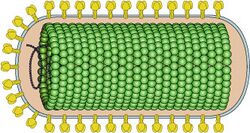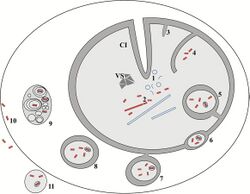Biology:Nudivirus
| Nudiviridae | |
|---|---|

| |
| Schematic drawing | |
| Virus classification | |
| (unranked): | Virus |
| Class: | Naldaviricetes |
| Order: | Lefavirales |
| Family: | Nudiviridae |
| Genera | |
| |
Nudiviruses are a family of animal viruses that constitute the family Nudiviridae.[1] Insects and marine crustaceans serve as natural hosts. There are 11 species in this family, assigned to 4 genera.[2] Diseases associated with this family include: death in larvae, chronic disease in adults.[2][3][4]
Structure and life cycle
Nudiviruses are characterized by rod-shaped and enveloped nucleocapsids and they replicate in the nucleus of infected host cells. In some parasitoid wasp species, a nudivirus genome, in proviral form, is integrated into the wasp genome and produces virus like particles called polydnaviruses that are injected into lepidopteran larvae and are thought to facilitate parasitization of the larvae. Nudiviruses infect only insects and marine crustaceans.[3]
Transmission of nudiviruses occurs generally by feeding or mating. Infections can be lethal for the larvae and can possibly reduce the fitness of the host by reducing offspring production and survival among adults.[5]
Taxonomy
The family Nudiviridae contains the following genera:[4]
- Alphanudivirus
- Betanudivirus
- Deltanudivirus
- Gammanudivirus
Phylogeny
Gene content comparison and phylogenetic analyses show that nudiviruses share 20 core genes with baculoviruses and form a monophyletic sister group with them. Fossil calibration estimate this association arose 100 million years ago(Mya), while the last common ancestor of BVs, nudiviruses, and baculoviruses existed approximately 312 Mya. Baculoviruses and nudiviruses differ in gene content, genome organization, cytopathology, infection of adults and most likely in host range.[6] The 20 core genes common in both baculoviruses and nudiviruses are involved in RNA transcription, DNA replication, virion structural components and many other functions.[7] Gene content and sequence similarity suggest that the nudiviruses GbNV, HzNV-1, and OrNV form a monophyletic group of nonoccluded double-stranded DNA viruses, which separated from the baculovirus lineage before this radiated into dipteran-, hymenopteran-, and lepidopteran-specific clades of occluded nucleopolyhedroviruses and granuloviruses.[6]
Host-virus relations
- Drosophila innubila nudivirus – Drosophila innubila (Diptera)
- Gryllus bimaculatus nudivirus – black cricket (Teleogryllus commodus)
- Helicoverpa zea nudivirus 1 – cotton bollworm
- Helicoverpa zea nudivirus 2 – cotton bollworm
- Homarus gammarus nudivirus - European lobster (Homarus gammarus)
- Oryctes rhinoceros nudivirus[8] – rhinoceros beetle Oryctes rhinoceros[9][10]
- Penaeus monodon nudivirus – black tiger shrimp
- Dikerogammarus haemobaphes nudivirus – an amphipod crustacean (Dikerogammarus haemobaphes)[11]
Defense mechanisms
In many organisms, apoptosis can be regarded as an early defense mechanism against viral infection. Some viral genes allow the cell to survive for longer while producing more virions; Heliothis zea Nudivirus 1 (HzNV-1 or Hz-1 virus), a nudivirus with a broad host range, has been shown to block an induced-apoptosis gene (hhi1). A functional anti-apoptosis gene, (Hz-iap2), has been found to suppress the hhi1 gene which can cause the cell to die. A second inhibitor gene (Ac-iap2) to the hhi1 gene has been also discovered, but its function is still uncertain.[12]
Nudivirus encoded microRNAs
Micro RNAs (miRNAs) are small non-coding RNA molecules that play important roles in the regulation of genes in eukaryotic organisms. Virus encoded miRNAs are commonly reported in DNA viruses[13] and several nudiviruses have been reported to encode miRNAs. The first reported nudivirus encoded miRNA was from Heliothis zea nudivirus-1 which was shown to regulate virus latency.[14] Two other viruses Drosophila innubila nudivirus and Oryctes rhinoceros nudivirus have also been reported to encode miRNA molecules from transcriptomic studies,[15][16] however the role of these miRNAs and their role in virus-host interactions is yet to be experimentally determined.
History
In 2007, the genus Nudivirus was proposed to include viruses similar to the Oryctes rhinoceros virus.[17] Nudiviruses were classified as the family Nudiviridae in 2013.[18]
Etymology
The word "nudivirus" comes from the Latin nudus, which means naked and virus, poison. Naked refers to the fact that most do not have the dense protein bodies which surround baculoviruses.[10] However occluded nudiviruses, with such protein bodies, such as those of Tipula oleracea and Penaeus monodon have been characterized.[19]
References
- ↑ Harrison, RL; Herniou, EA; Bézier, A; Jehle, JA; Burand, JP; Theilmann, DA; Krell, PJ; van Oers, MM et al. (January 2020). "ICTV Virus Taxonomy Profile: Nudiviridae.". The Journal of General Virology 101 (1): 3–4. doi:10.1099/jgv.0.001381. PMID 31935180.
- ↑ 2.0 2.1 "ICTV Report Nudiviridae". http://www.ictv.global/report/nudiviridae.
- ↑ 3.0 3.1 "Viral Zone". ExPASy. http://viralzone.expasy.org/all_by_species/4757.html.
- ↑ 4.0 4.1 "Virus Taxonomy: 2020 Release". International Committee on Taxonomy of Viruses (ICTV). March 2021. https://ictv.global/taxonomy.
- ↑ Unckless RL. (2011) A DNA Virus of Drosophila. Published online 2011 October 28
- ↑ 6.0 6.1 Mayo, M.A. (1995). Unassigned Viruses. In: Virus Taxonomy: The Sixth Report of the International Committee on Taxonomy of Viruses. Springer-Verlag, Wien. pp. 504–507.
- ↑ Wang, Yongjie; Jehle, Johannes A. (2009). "Nudiviruses and other large, double-stranded circular DNA viruses of invertebrates: New insights on an old topic". Journal of Invertebrate Pathology 101 (3): 187–193. doi:10.1016/j.jip.2009.03.013. PMID 19460388.
- ↑ "Oryctes rhinoceros nudivirus". CABI (Centre for Agriculture and Bioscience International). 2019-11-24. http://www.cabi.org/isc/datasheet/37975.
- ↑ Marshall, Sean D.G.; Moore, Aubrey; Vaqalo, Maclean; Noble, Alasdair; Jackson, Trevor A. (2017-10-01). "A new haplotype of the coconut rhinoceros beetle, Oryctes rhinoceros, has escaped biological control by Oryctes rhinoceros nudivirus and is invading Pacific Islands". Journal of Invertebrate Pathology (Academic Press (Elsevier)) 149: 127–134. doi:10.1016/j.jip.2017.07.006. ISSN 0022-2011. PMID 28743668.
- ↑ 10.0 10.1 Moscardi, Flávio (1999). "Assessment of the Application of Baculoviruses for Control of Lepidoptera". Annual Review of Entomology (Annual Reviews) 44 (1): 257–289. doi:10.1146/annurev.ento.44.1.257. ISSN 0066-4170. PMID 15012374. "p. 260, "This strategy has been successful with the non-occluded virus of the rhinoceros beetle, Oryctes rhinoceros, in coconut palms (183)."".
- ↑ Allain, Thomas W.; Stentiford, Grant D.; Bass, David; Behringer, Donald C.; Bojko, Jamie (2020-09-09). "A novel nudivirus infecting the invasive demon shrimp Dikerogammarus haemobaphes (Amphipoda)" (in en). Scientific Reports 10 (1): 14816. doi:10.1038/s41598-020-71776-3. ISSN 2045-2322. PMID 32908207. Bibcode: 2020NatSR..1014816A.
- ↑ Wu, Yueh-Lung; Wu, Carol P.; Liu, Catherine Y. Y.; Lee, Song-Tay; Lee, Hsiao-Ping; Chao, Yu-Chan (2011). "Heliothis zea Nudivirus 1 Gene hhi1 Induces Apoptosis Which Is Blocked by the Hz-iap2 Gene and a Noncoding Gene, pag1". Journal of Virology 85 (14): 6856–6866. doi:10.1128/JVI.01843-10. PMID 21543471.
- ↑ Kincaid RP, Sullivan CS (2012). "Virus-encoded microRNAs: an overview and a look to the future.". PLOS Pathog 8 (12): e1003018. doi:10.1371/journal.ppat.1003018. PMID 23308061.
- ↑ Wu YL, Wu CP, Liu CY, Hsu PW, Wu EC, Chao YC (2011). "A non-coding RNA of insect HzNV-1 virus establishes latent viral infection through microRNA.". Sci Rep 1: 60. doi:10.1038/srep00060. PMID 22355579. Bibcode: 2011NatSR...1E..60W.
- ↑ Webster CL, Waldron FM, Robertson S, Crowson D, Ferrari G, Quintana JF (2015). "The Discovery, Distribution, and Evolution of Viruses Associated with Drosophila melanogaster.". PLOS Biol 13 (7): e1002210. doi:10.1371/journal.pbio.1002210. PMID 26172158.
- ↑ Etebari K, Parry R, Beltran MJB, Furlong MJ (2020). "Transcription Profile and Genomic Variations of Oryctes Rhinoceros Nudivirus in Coconut Rhinoceros Beetles.". J Virol 94 (22). doi:10.1128/JVI.01097-20. PMID 32878889.
- ↑ Wang, Y.; van Oers, M.M.; Crawford, A.M.; Vlak, J.M.; Jehle, J.A. (2007). "Genomic analysis of Oryctes rhinoceros virus reveals genetic relatedness to Heliothis zea virus 1". Archives of Virology 152 (3): 519–531. doi:10.1007/s00705-006-0872-2. PMID 17106621.
- ↑ ICTV proposals 2013.003a-KI et al., J. E. Jehle et al. Retrieved 21 November 2015.
- ↑ "The genome of the nucleopolyhedrosis-causing virus from Tipula oleracea sheds new light on the Nudiviridae family". J. Virol. 89 (6): 3008–25. March 2015. doi:10.1128/JVI.02884-14. PMID 25540386.
Wikidata ☰ Q18811654 entry
 |


